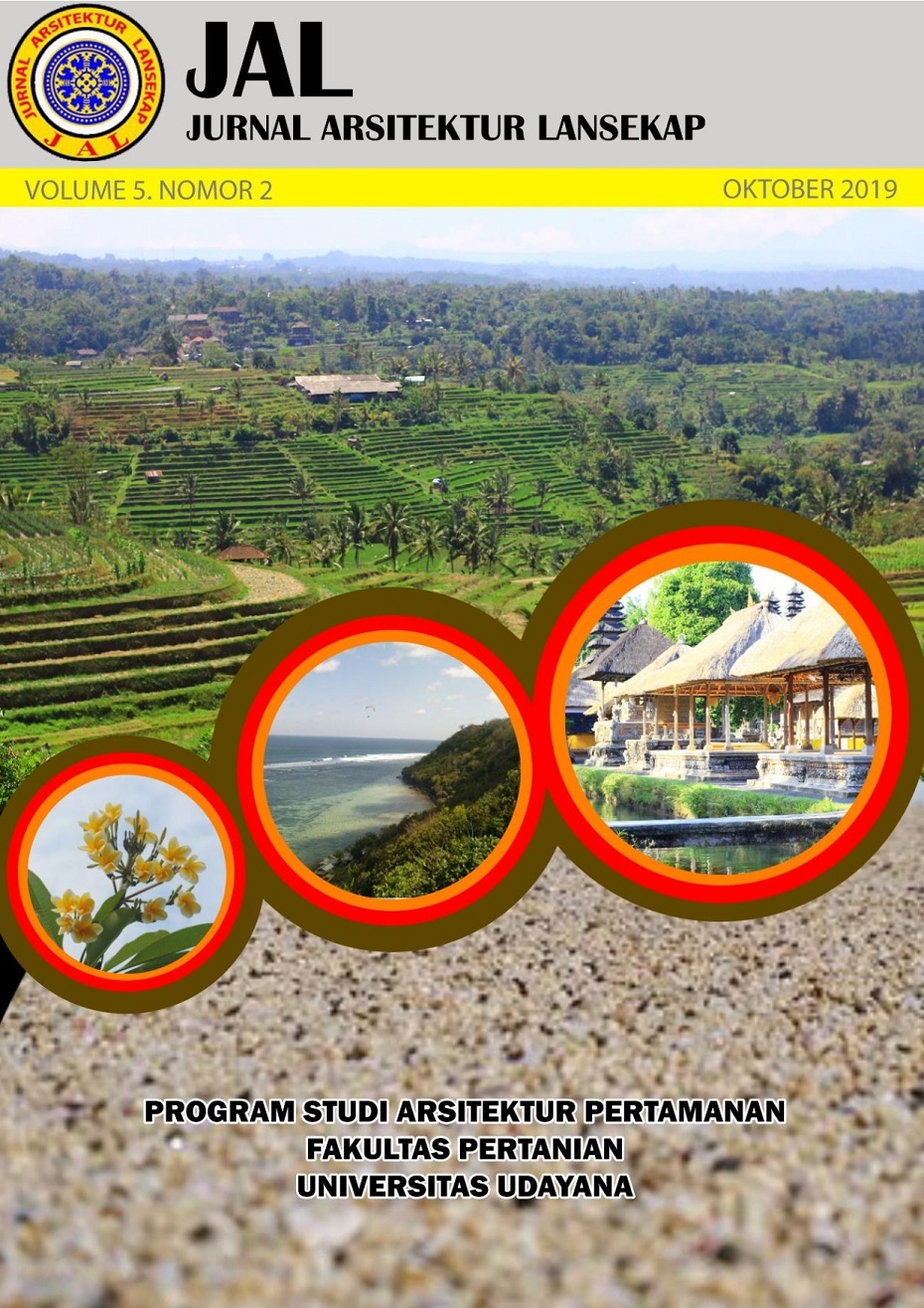Identifikasi struktur dan perubahan lanskap Kota Banjarmasin di masa kesultanan (1526-1860)
Abstract
Identifying the structure and transformation of Banjarmasin townscape during the Sultanate period
(1526-1860): Banjarmasin city in the past was widely known as one of the main pepper producers in the
Archipelago that turned the town to becoming one of the port cities in the Southeast Asia maritime trade
network. As a port city, Banjarmasin showed a typical landscape character similar to other port cities in
Southeast Asia. The physical landscape feature of this city inevitably was influenced by the economic factor
on which trade was the primary income of the sultanate and its people. During the Sultanate period (15261860),
the landscape of Banjarmasin was transformed as an impact of the political influence that related to the pepper trade, which involved foreign traders. The main objective of this study is to analyse the landscape changing of Banjarmasin during the Sultanate period by applying the historical method and spatial approach.
In the spatial analysis, the landscape component of processes, space, material, and form was used to identify
the landscape structure and its transformation. The result of the study shows that the landscape of Banjarmasin
evolved in the following stages: (1) port-polity of Banjar sultanate (1526-1612); (2) secondary port-city of the
sultanate (1612-1663); (3) primary port of the sultanate (1663-1787); (4) primary port of the Dutch in Southeast
Kalimantan (1787-1860). With regard to the research process, the spatial dimension was not only obtained
from the historical maps but also from written sources that indicated the location of activities or events.
Downloads
References
ANRI. 1963. Surat-surat Perdjandjian antara Kesultanan Bandjarmasin dengan Pemerintah2 VOC, Bataafse Republik, Inggeris dan Hindia Belanda 1635-1860. ANRI, Jakarta.
BAPPEKO Banjarmasin. 2006. Revisi Rencana Umum Tata Ruang Kota (RUTRK) Banjarmasin 2001-2011. Badan Perencanaan Pembangunan Kota (BAPPEKO), Banjarmasin.
Bataviaasch Genootschap van Kunsten en Wetenschappen. 1891. Dagh Register Gehouden int Casteel Batavia vant passerende daer ter plaetse als over geheel Nederlandts-India, Anno 1663. G. Kolff, Batavia.
Beckman, D. 1718. A Voyage to the Island of Borneo in the East-Indies. T Warner, London.
Chang, T.K. 1954. Historical Geography of Chinese Settlement in the Malay Archipelago. Disertasi Univ. of Nebraska (tidak dipublikasikan).
De Roy, J.J. 1706. Voyaagie gedaan door Jacob Janssen de Roy, na Borneo en Atchin, in ’t jaat 1691 en vervolgens. Pieter vander Aa, Batavia.
Fong, C.Y. 1970. The Chinese in Banjarmasin during the first half of the eighteenth century. Journal of the Historical Society, Univ. of Malaya Vol 8.
Gais, JW. 1922. The early relations of England with Borneo to 1805. H Beyer, Langensalza.
Ganie, T.N. 2011. Sejarah kehidupan di Tanah Banjar. Tuas Media, Martapura.
Knapen, H. 2001. Forests of Fortune? The environmental history of Southeast Borneo, 1600-1880. KITLV Press, Leiden.
Marcucci, D.J. 2000. Landscape history as a planning tool. Landscape and Urban Planning 49: 67-81. https://doi.org/10.1016/S0169-2046(00)00054-2
Müller, S. 1857. Reizen en onderzoekingen in den Indischen Archipel, gedaan op last der Nederlandsche Indische regering, tusschen de jaren 1828 en 1836. Vol. 1. F Muller, Amsterdam.
Ras, J.J. 1968. Hikajat Bandjar: A study in Malay Historiography. Martinus Nijhoff, The Hague.
Reid, A. 1980. The Structure of Cities in Southeast Asia, Fifteenth to Seventeenth Centuries. Journal of Southeast Asian Studies Vol. 11 (2): 235-250.
Reid, A. 1993. Southeast Asia in the Age of Commerce, 1450-1680. Vol. 2, Expansion and Crisis. Yale Univ. Press, New Haven.
Saleh, M.I. 1982. Banjarmasih. Museum Negeri Lambung Mangkurat, Banjarbaru.
Schwaner, C.A.L.M. 1853. Borneo, Vol I. PN van Kampen, Amsterdam.
Spirn, A.W. 1998. The Language of Landscape. Yale Univ. Press, New Haven and London.
Subiyakto, B. 2004. Infrastruktur Pelayaran Sungai Kota Banjarmasin Tahun 1900-1970. Prosiding, The first International Conference on Urban History.
Sumawinata, B. 1998. Sediments of the Lower Barito Basin in South Kalimantan: Fossil Pollen Composition. Southeast Asian Studies 36(3): 293-316.
http://hdl.handle.net/2433/56685
Valentijn, F. 1726. Oud en nieuw Oost-Indiën Deel III, Part 2. Joannes van Braam, Amsterdam.
Van der Kemp, H. 1898. Het Afbreken van Onze Betrekkingen Met Bandjermasin Onder Daendels en de Herstelling van Het Nederlandsch Gezag Aldaar op den 1 N Januari 1817. Bijdragen Tot De Taal-, Land- En Volkenkunde Van Nederlandsch-Indië, 49(1) :1-168.
Van Dijk, L.C.D. 1862. Neêrlands vroegste betrekkingen met Borneo, den Solo-Archipel, Cambodja, Siam en Cochin-China: een nagelaten werk. JH Scheltema, Amsterdam.
Van Wijk, .CL. 1951. Soil Survey of the Tidal Swamps of South Borneo in Connection with the Agricultural Possibilities. Ministry of Agriculture, Bogor.
Dokumen arsip
ANRI Jakarta (Arsip Nasional Republik Indonesia, Jakarta), Marginalia to the Daily Journals 1659-1807, file 2531 folio 499-50, Item een rapport van den ondercoopman Jan de Wolf wegen desselfs wedervaren tot Banjar, 18 July 1707.
NA Den Haag (Nationaal Archief, Den Haag), Collectie 460 J.B. Osten, 2.21.205.45, inv.nr. 9, Rapporten betreffende de forten en posten te Bandjermassin, 1818, 1822.
An author who publishes in the Jurnal Arsitektur Lansekap (JAL) agrees to the following terms:
- Author retains the copyright and grants the journal the right of first publication of the work simultaneously licensed under the Creative Commons Attribution-ShareAlike 4.0 License that allows others to share the work with an acknowledgement of the work's authorship and initial publication in this journal
- Author is able to enter into separate, additional contractual arrangements for the non-exclusive distribution of the journal's published version of the work (e.g., post it to an institutional repository or publish it in a book) with the acknowledgement of its initial publication in this journal.
- Author is permitted and encouraged to post his/her work online (e.g., in institutional repositories or on their website) prior to and during the submission process, as it can lead to productive exchanges, as well as earlier and greater citation of the published work (See The Effect of Open Access).
Read more about the Creative Commons Attribution-ShareAlike 4.0 Licence here: https://creativecommons.org/licenses/by-sa/4.0/.







